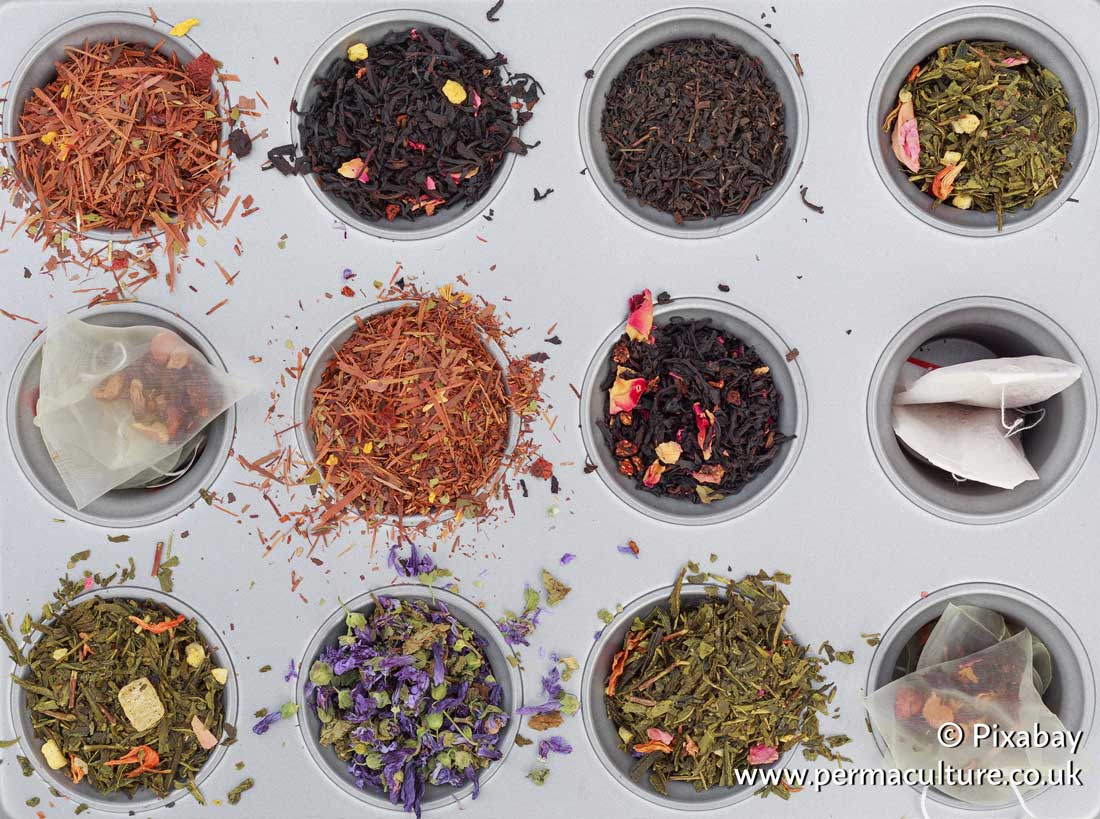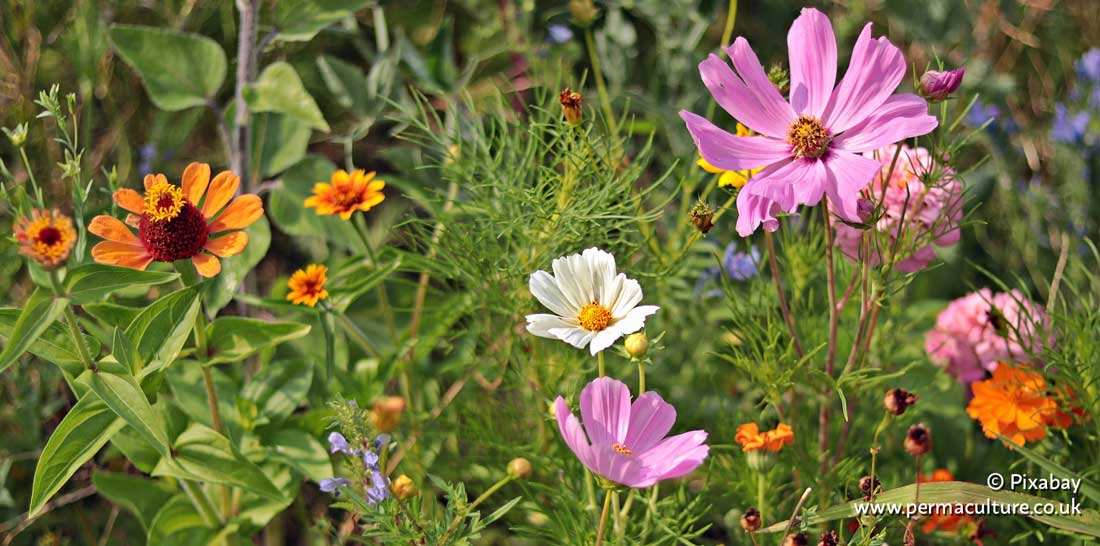There are many tips about how to fight these invertebrates circulating around allotments and gardens – some are fables, some are more effective than others. The reality is that no single thing does the trick. In short, the solution is to create an ecosystem in your garden that will help to create a balance. A plague is caused by an imbalance, a lack of predators that keep the population of slugs under control. Sounds easier than it is, but if you love your garden it greatly increases the joy and once established it looks after itself!
A number of years ago I started a forest garden in the middle of a very wet woodland, in the midst of a slug stronghold. I could easily collect a large jarful of slugs at dusk. After an intensive research and learning process with many failures, I only had to go out with a torch in the dark once every week or so and even then I only found a few. I was able to grow anything I liked without losing many plants to slugs. I have had to learn to live with some losses but still feel I can shout “Victory!”
Here is what I learned:
There are a lot of different kinds of slugs and some are more harmful than others. The large black slug doesn’t do much damage at all as they prefer rotting matter, dung and carrion above living plants. The garden slug is the opposite, attacking anything that even slightly resembles an herbaceous plant.
The most harmful slugs:

Some slug characteristics:
Nematodes:
This is the quickest, most effective, least labor intensive biological method to secure a slug free area for up to six weeks. One treatment for about 40 square meter costs around £20 at the moment. Nematodes are microscopically small worms that parasitise and kill slugs. The nematodes are watered on to the soil surface, who then actively search for their prey and invade it. Special bacteria, living in symbiosis with the nematodes, are released, multiply rapidly and act as food for the nematodes. An infected slug stops feeding within three to five days and then displays a typical swelling. The nematodes multiply inside the slug and when it starts to decompose, a new generation of nematodes spreads and starts looking for the next prey. The nematodes work for up to six weeks.
This cure has a serious side effect though. It is too successful. By eliminating all the slugs, we are also taking away food for the predators that eat the slugs or its eggs and we drive away the predators in a hunt for food. The result is that we create the perfect scenario for a slug plague: An area rich in food for slugs with few predators. Party time! In effect we become addicted to the quite expensive cure. In my journey so far I have only used it in one garden and only on a small part of it, because the plague was so bad.
Frogs:
Having a pond in the garden has many benefits. It greatly increases wildlife and the beauty. It allows birds and insects to drink. And you can grow food and flowers in the pond and on the edge. If you don’t keep fish, ducks or herons, you can keep frogs. Apparently it is illegal to collect frog spawn from the wild. I understand that wildlife needs to be protected against ignorance so I want to encourage you to do loads of research for yourself and I won’t encourage you to go to pond nearest to your garden to gently and with great care collect only a little bit frog spawn with some pond water for your own haven for wildlife. Frogs are only fertile after two years, so I will not encourage you to do it two years in a row. The little frogs hopping about hunting for slugs are delightful. It is a joy to see them! It encouraged me to tread gently in the garden, which can only be a good thing.
Toads:
Toads do not need a pond. If you provide enough moist hiding spaces they will most likely be attracted by the abundance of food.
Slow worms:
These beautiful creatures are becoming rare and are strictly protected. It really is not a good idea to pick them in the wild. So the only way to get them in your garden is to provide a good shelter and hope they turn up. A sheet of corrugated iron or black plastic in a slightly raised and sunny spot near the compost heap seems best (dry and warm). Slow worms feed mostly on slugs. If you have them, protect them well they are a great ally!
Hedgehogs:

There is an issue whether it is ethically justified to keep them in the perimeter of an allotment or garden. I think it is – if the hedgehog would otherwise have been culled and has a habitat that is able to provide it with all the essentials it needs. North Uist and Benbecula on the west coast of Scotland have had to take drastic steps to save the ground nesting birds as the hedgehogs were wiping them out by eating the eggs. Uist Hedgehog Rescue is a charity trying to save (deport rather than kill) hedgehogs from a certain death. I received the hedgehogs in the picture from the Hessilhead Wildlife Rescue Trust.
It is not easy to persuade them to give you a hedgehog as they want to come and look for themselves whether it is safe for hedgehogs. A road or badgers nearby would give you a negative reply.
If you are lucky enough to have a hedgehog, don’t treat it as a pet. It is a wild animal after all. A hag pile and some decent fencing to stop it going on the road is important as protection. Make sure there is enough food for it in the garden (don’t wipe out all the slugs). Don’t leave out cat food as it attracts vermin, don’t give it milk and don’t de-flea it as that would kill it.
Ducks:
Ducks are a great slug predator. Experts recommend the Khaki Campbells or Indian Runners who are the best carnivores – other breeds might eat more of your vegetables. Some people really swear by them and really recommend these animals. A good permaculture solution would be to have your garden in between the duck hut and the pen. Thereby allowing the ducks a good munch in the morning and evening while on the way to and from home. Ducks do eat frogs! Do not mix.
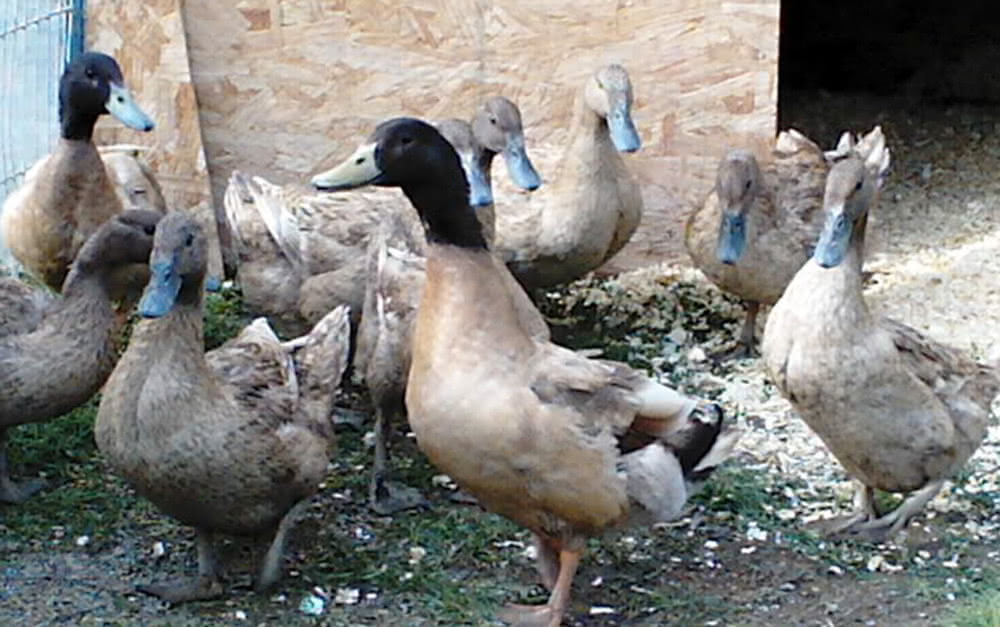
Beetles:
Carob beetles (Violet Ground beetle on the left and the Common Ground beetle on the right) are very effective slug predators – the larvae and beetles eat the eggs and the tiny slugs. If suitable homes are provided they can appear in huge numbers!
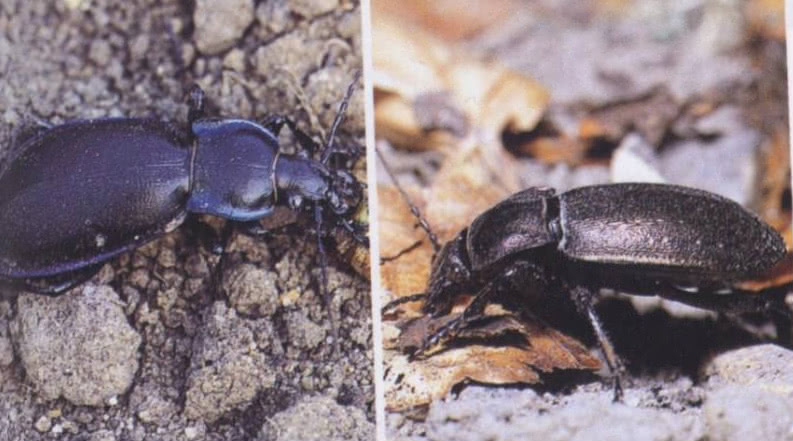
If you have these beetles in your garden, you can help them by providing a good home for them. Some patches between your beds with tough grasses or sedges, some straw or hay in an upside down plastic box, some stones for the beetles to live under, raised beds, well drained soil are all good. Try to make the access holes strong and tiny so that mice can’t get in (you can wrap the boxes with some fine mesh chicken wire). The beetles are tirelessly on the hunt all night!
Larger gardens or farms can encourage these animals by making a beetle bank.
Centipedes:
Centipedes are carnivorous nocturnal hunters. Learn to distinguish between the millipedes and centipedes, as millipedes are herbivores and love young seedlings. The centipedes I know are harmless. Rumours of people being bitten are going around, but I have never met anyone who has been bitten by them. Centipedes like it moist so live in leaf litter, under stones, in rotting wood, etc. They are equipped with some ferocious weapons. I have only respect for them.
There are plants out there that slugs like better than your vegetables. If you grow them in your garden they will attract the slugs and all you will need to do is pick them up at dusk or put a slug trap nearby.
Lawn camomile is my favourite because it is most effective in spring when my seedlings are small and most vulnerable. It is a perennial, so when the annuals are at the most vulnerable, the camomile is in full swing already. Rubbing the plant whilst looking for slugs releases the scent that attracts the slugs. I use it a lot.
Try to discover what slugs like better than your vegetables. Experiment with cut salad leaves and juicy plants left out between your plants.
This part of the exercise is the most difficult and contentious. In the early part of my ‘career’ I used to catch slugs in a jar and deport them. Until I realised that, in essence I was transporting an imbalance from one ecosystem to another, thereby creating a problem elsewhere. For the sole reason that I was too much of a coward to deal with the problem myself and too afraid of a bad conscience and bad karma. I wasn’t even solving the problem because deporting slugs and depositing them at a distance creates a high slug pressure that gets deflated by the low slug pressure that sucks them back in! Transporting them elsewhere is like mopping up water while the tap is running – now I kill them without mercy with a method as humane as possible. After all, if there had been enough predators they would more than likely have fallen prey.
The most effective way of finding them is to go out with a torch just after dusk or on a miserable grey wet day – make sure to look on the underside of the vegetable leaves. Let the plant damage and slime trails guide you. I feed some to my frogspawn – they fight for them! (And I hope it helps them to develop a taste for slugs when they are older!)
Picking them by hand can be a messy business. Some species produce a slime that is really persistent. Some people use tongs, chopsticks or garden gloves.
These are a few of the most used weapons:
Jar: You can drown them by putting them in a jar filled completely with water and keeping the lid screwed on tightly. Some say soapy water kills them. A bucket with water is not good enough, the slugs will just crawl out again.
Knitting needles are useful to make slug sis kebab! (Sorry)
Beer traps: After trying several designs this is the winner:

Slugs seem to get drunk and forget to crawl out again and drown.
The slugs are attracted by the fermentation gasses of beer. Any cheap lager or homebrew is good, though ales and Guinness are best. Use a beer that has a good fermentation. The bait works even better when the slug corpses become part of the fermentation process. At that point it is rather smelly, yet effective, so top up the beer or replace after a while, as desired.
Beer of 2% is enough. If a higher percentage, dilute the beer with water.
Other creatures fall in somes too, especially the predator beetles mentioned above. They don’t get drunk and do want to get out again – a stick helps as an exit ladder. Also try to make sure that the entry holes are a bit above soil level. Slugs have no problem with the smooth plastic surfaces, unlike other creatures.
Place the traps at the edge of the beds. If you place them in the middle, slugs might get distracted by your juicy vegetables on the way to the pub.
Other traps: Many other traps can be used. Grapefruit halves, flower pots, cardboard, anything dark and moist will be favored by the slugs as a hiding place during the day. Inspect and capture at your leisure.
Sharp knife: My preferred method at the moment is a sharp knife. I use it flick the slugs of the plant onto the soil surface and behead the poor things. I think it is the quickest death and the most convenient as a pocket knife is easily carried on you as standard gardener equipment.
Copper: Slugs don’t like to crawl over copper. With some cleverness, one can come up with some really effective borders. A dozen or so pennies stuck into the soil around a seedling can form a border. A stripped electrical cable is even better and cheaper. With some imagination a seedling or potting table can be very large and still only have four legs, with copper cable wound around them.
To protect a precious plant, strip an old cable from its plastic insulation – you can use a proper stripping tool, but I press it against a hot wood burning stove until it is soft and then strip it using my fingernails or a knife. Cut the top and the bottom of a recycled plastic bottle. Wrap the cable a few times around it with one or two loops in it, fasten it to the bottle with duck tape through the loops and flatten the copper loops to the plastic – done! Dig the plastic in the soil so that slugs don’t crawl underneath.
Tip: If you use sticks to support the plant, wrap copper around the sticks too. Make sure none of the leaves touch the ground or any weeds touch the plant. Slugs can’t fly but they know how to find shortcuts!
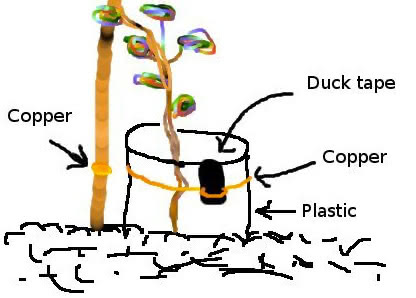
Eggshells:
The sharp edges of eggshells help as a deterrent, but only when they are clean and dry. When peeling an egg, try to remove the inner membrane and rinse if needed. I put them in an empty cooking pot on my wood burning stove to help dry them out. Be aware that rain quickly makes the eggshells lose their effectiveness.
Slug repellent plants:
Some plants are better at repelling than others. I read reports on the internet that conflict with my experience. I know that chives work well. They are easily laid or tied around plants as well. I am experimenting further.
Other borders:
Many suggestions like: wood ash, sharp sand, charcoal dust, charcoal left overs after a barbecue, lava rock, are being made, most only work when the garden is dry. As I live and work mostly in Scotland I have not bothered to investigate these options as they are not that useful to me. Borders that stop working when the ideal slug environment has arrived seem a bit pointless to me.
Salt: Pouring salt around your veg will keep the slugs away indeed, but unless your plants like maritime conditions they will die too!
Seashells: The sharp edges deter slugs from crossing, but they don’t decay like eggshells and can be a serious nuisance when weeding for many years to come.
Slug pellets: Most are not organic and will kill the predators too. Even the organic ones are not wise to use: when the slugs die, the predators leave to find food elsewhere – leaving you dependent on the pellets.
And please be grateful to your new found allies for the help.
Watch Permaculture teacher Patrick Whitefield, explain slug preventation and watering seedlings
Ludwig Appeltans is a permaculture designer and teacher. He has studied with Patrick Whitefield and trained with Designed Visions and writes a regular blog at http://earth-ways.co.uk. He is passionate about protecting and caring for the environment.
